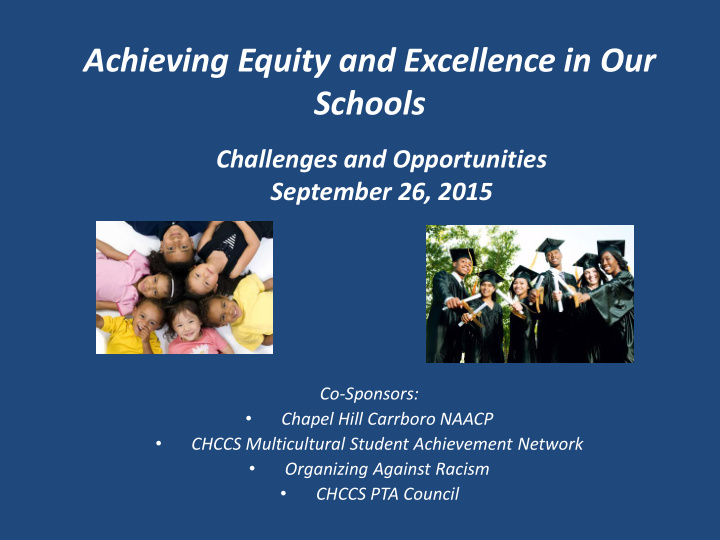



Achieving Equity and Excellence in Our Schools Challenges and Opportunities September 26, 2015 Co-Sponsors: • Chapel Hill Carrboro NAACP • CHCCS Multicultural Student Achievement Network • Organizing Against Racism • CHCCS PTA Council
Excellence Gaps Chapel Hill – Carrboro City Schools 100% 90% Grade Level Proficiency, 2014-15 53 59 58 % % % 47% 42% 41% Low Income White African Am Latino
Reading Gaps Have Been Widening Source: Diane Villwock, Chapel Hill Carrboro City Schools, 2015
Math Gaps Have Been Widening Source: Diane Villwock, Chapel Hill Carrboro City Schools, 2015
Some District Schools Doing Better Than Others Grade Level Proficiency, 2014-15 100% Grade Level Proficiency, 2o14-15 90% 80% 70% 60% 50% 40% 30% 20% 10% 0% % White % Low Income Carrboro Elementary Ephesus Elementary Estes Hills Elementary FPG Elementary Glenwood Elementary McDougle Elementary Morris Grove Elementary Northside Elementary Rashkis Elementary Scroggs Elementary Seawell Elementary Culbreth Middle McDougle Middle Phillips Middle Smith Middle Carrboro High Chapel Hill High East Chapel Hill High Source: NC Dept of Public Instruction, 2015
Good News-90%+ Graduating CHCCS 4-5 Year Graduation Rate Low Income White Latino Asian Af Am All 0% 10% 20% 30% 40% 50% 60% 70% 80% 90% 100% 110% 2015 2014 Source: Dianne Villwock, CHCCS, 2015
Disproportionate Discipline Issue CHCCS, 2013-14 Source: Nancy Kueffer, CHCCS, 2015
Disproportionate Discipline Issue CHCCS, 2013-14 Source: Nancy Kueffer, CHCCS, 2015
Are CHCCS Schools Excellent? Excellence Through Equity = E 2 But, how do we get there?
Wonder what happened to that fish? How could it have lived and thrived?
Should we be examining each fish or the lake itself?
Implicit Bias: What Is It? • Attitudes or stereotypes that affect our understanding, actions, and decisions in an unconscious matter.
Implicit Bias: Why? • Research shows that we only have conscious access to 2- 5% of our brain’s processing • The rest is unconscious.
Implicit Bias: Why? • The unconscious brain is fast; the conscious brain is slow (Kahneman, Thinking Fast and Slow ) • This is adaptive for efficiency and for safety.
Implicit Bias: How? • As infants and young children, we consciously and unconsciously learn to categorize things and to develop associations. • Food, animals, weather, fire, people. • We might be taught that all people are the same, but there are many messages in our environment that teach us otherwise. • Harmful, when our associations make us categorize people.
How is it harmful? • Employers; apartment managers • Health practitioners • Law enforcement • Judicial officers • Bankers/loan officers • Retail clerks • Teachers/college professors
Some examples from Education • Low expectations • Disproportionate discipline for the same infractions. Black and brown students referred to the office for less serious and more subjective offenses. • Black and brown students disproportionately tracked (out of advanced coursework, into special education) • Stereotype threat
What Can We Do? • First what not to do: Cannot be COLORBLIND. • It’s impossible, disingenuous, and counterproductive. Gives the impression that the color of skin & America’s racial history should be politely ignored.
Can we change unconscious thinking? • More education in the causes & consequences • Implicit bias does not mean we are racist or bad people; it means we are human. • Recognizing that we have it allows us to hold it in check • Denying it increases it!
Can we change unconscious thinking? • Practice & develop tools (e.g., Desk Card) • Recognize times when implicit bias is likely to be greatest (stress, fear, busy, low accountability about our decisions) • Critically evaluate school practices, curricula, media and other exposures that create and/or reinforce implicit bias. • Educate students about unconscious bias & to be agents of change to improve opportunity
GOALS AND RECOMMENDATIONS
Excellence for All is Possible — Montgomery County Example Source: RAISING ACHIEVEMENT AND CLOSING GAPS IN WHOLE SCHOOL SYSTEMS: RECENT ADVANCES IN RESEARCH AND PRACTICE 2008 Conference Report, Harvard Achievement Gap Initiative
Excellence for All is Possible — Taft High School in Ohio
Excellence for All is Possible — Learning Focused Work in 57 Schools Source: Learning Focused
Excellence for All is Possible — Learning Focused Work in 57 Schools Source: Learning Focused
Excellence for All is Possible — Learning Focused Work in 57 Schools Source: Learning Focused
Recommendations For Consideration Starting Point: Commitment to Help All be Successful Accountability For Results Create climate in which All students value themselves and each other All parents, teachers, and staff feel valued and supported All students recognize that they can achieve much Excellence is the norm for all ethnic and socio-economic groups Disproportionate discipline is eliminated
Establish Definitive, Aggressive Targets Example: Achieve 10-15 percentage point annual increase in percent proficient for groups not currently being reached effectively Eliminate disproportionate discipline within 2 years Achieve proportionate and successful access to all accelerated classes within 3 years
Recommend
More recommend